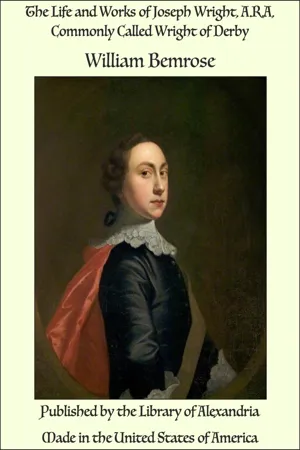
The Life and Works of Joseph Wright, A.R.A, Commonly Called Wright of Derby
- 213 pages
- English
- ePUB (mobile friendly)
- Available on iOS & Android
The Life and Works of Joseph Wright, A.R.A, Commonly Called Wright of Derby
About This Book
THE name of Joseph Wright, of Derby, once of high repute among English Artists, has, during the last half-century and more, sunk, altogether undeservedly, into a state of semi-oblivion. The Exhibition at Derby in 1883 did, indeed, something to restore its fame, and it is to be hoped that the present work may do yet more. Both book and exhibition owe their existence mainly to the exertions of Mr. Bemrose, who in this matter may be said to have been moved by a triple love—the love of art, the love of family, and the love of locality. By his kindness I am allowed here to aid in doing justice to an artist of whom not only Derby, but England, should be proud. Even if such a feat were possible, I should have no wish to compare accurately the merits of Wright with those of his forerunners and contemporaries. It will, however, be generally acknowledged that between such names as Hogarth, Reynolds, Gainsborough, and Wilson, and such as West, Northcote, Barry, and Hamilton, there is a gap—sensibly to be felt. In this gap, but nearer to the greater than to the lesser men, a place has of late years been found for Romney. It is but a modest claim for Wright that the same distinction should be accorded to him. As a painter, his method, in relation to that of Reynolds and Gainsborough, may be said to have been old-fashioned. His pure, precise touches, his level surface, and clear enamelled colours, have not, indeed, the variety of texture or the inspired freedom of a Franz Hals. His practice was nearer to that of Van der Helst, and a host of other illustrious artists to whom clear, clean, work was dear. Through Kneller, and Hogarth, and Hudson, it came to him from Holland; and if he did not reform it, he mastered it, and left his mark upon it. As a colourist, he was scarcely an innovator; but he was still less of a copyist. In this and most other respects a "naturalist, " he did not allow a preference for certain harmonies to dominate his work; but though his colour missed the charm of inspiration, it never failed in harmony. He had the colour sense, and a command of the whole scale. In his candle-light pieces the prevailing hues were determined by his subject; but the way in which he united the blazing reds and yellows of the central glare to the rich browns of his transparent shadows, warmed and cooled these shadows with gleams of red coat and glimmers of blue sash and white dress, and from the ruddy glow of the chamber to the cool night outside, led the eye, untired, showed rare taste, as well as skill. If we take his portraits by ordinary light, we find the same fine power. The group of Mr. Newton's children, with its blue boy, its olive-green boy, and its girl in white and gold, set off with rich green foliage and clusters of ripe cherries, is a masterpiece of colour. In these daylight portraits, all the favourite colours of the dress of the period are introduced and reconciled. The hues and textures of the buff waistcoat, the "nankeen" breeches, the puce slip, the cinnamon coat, and the pink shoes, are imitated with the same sure skill, the same artistic impartiality. Only in regard to one colour do we find a decided preference, and this is neither the blue of Gainsborough nor the red of Reynolds, but what may be called the green of Wright. Probably no other artist has treated this colour with such variety. It tinges those bladders of which he was so fond; we find it lightly in the stone-coloured coat of Mr. Cheslyn, and deeply in the arm of his chair; in pale cucumber the artist robed his pitiful "Maria"; and from that fine picture of himself in the National Portrait Gallery we learn that it was green that he elected to wear in his youth when he wished to look particularly spruce.
Frequently asked questions
Information
Table of contents
- THE LIFE AND WORKS